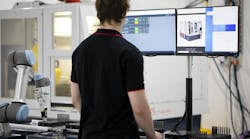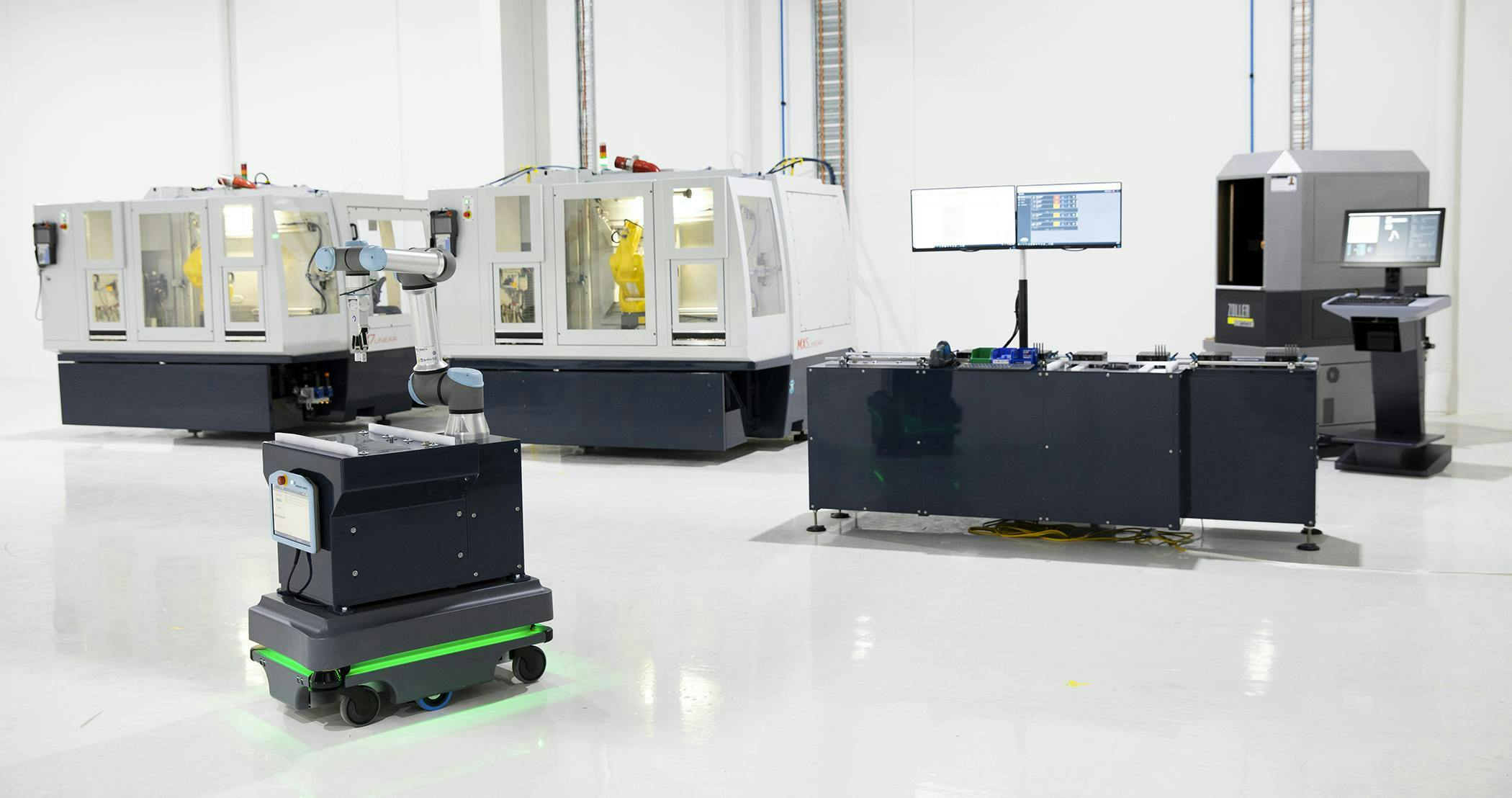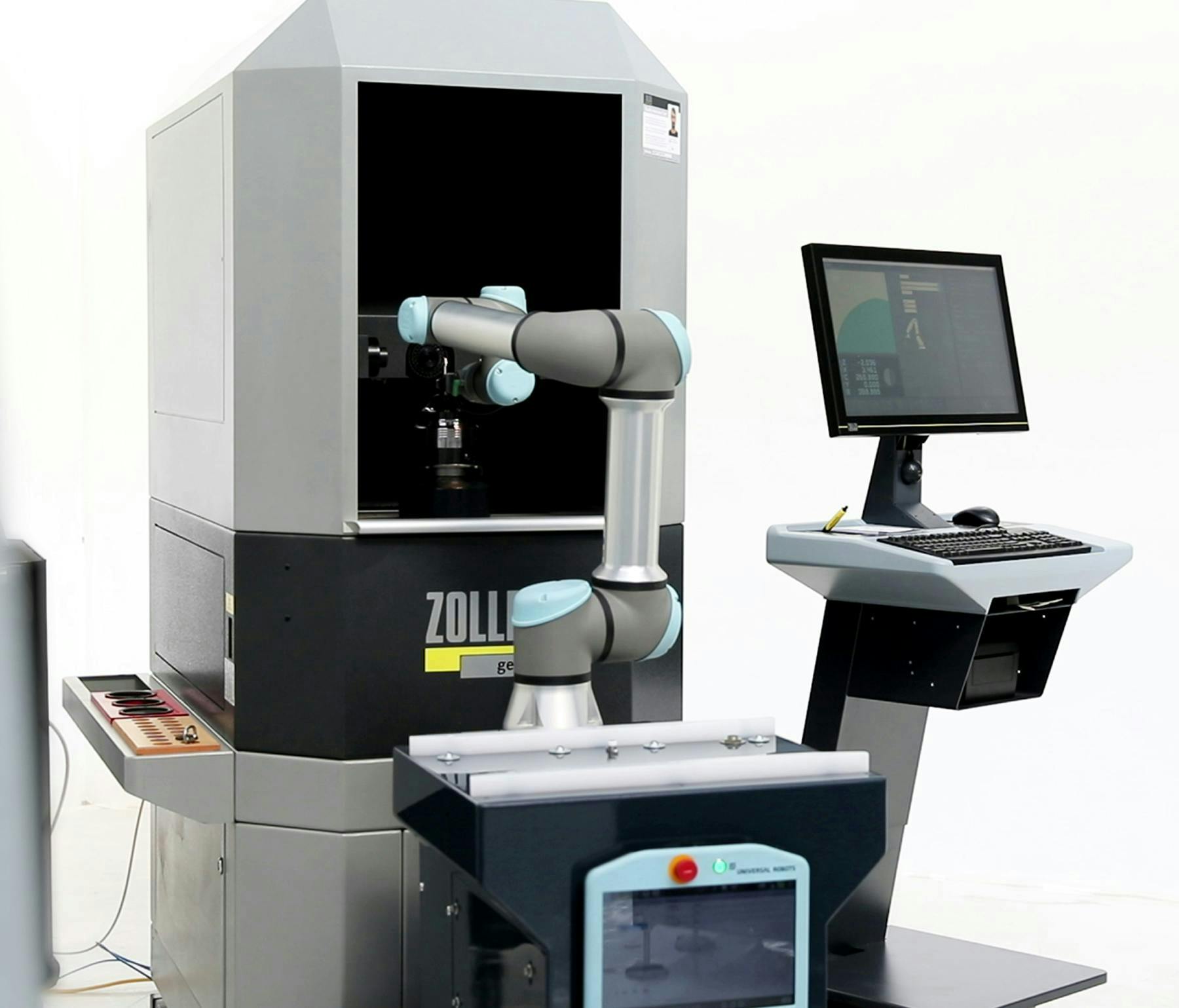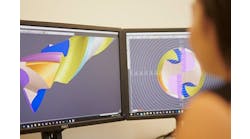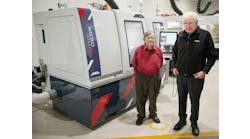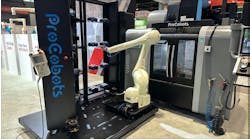ANCA CNC Machines, based in Melbourne, Australia, wants to enable autonomous manufacturing, full end-to-end production without human interaction. The company primarily makes computerized numerical control (CNC) machines for the tool and cutter industries, and ANCA’s technical manager for systems engineering, Samuel Kirkpatrick, believes emerging technologies are influencing machine design and older tech is morphing to meet the challenge for more automation.
“We're starting to provide automation-as-a-service for our customers, where we're automating things like material transfer and workflow definition between all the processes for tool manufacturing, as well as providing solutions for closed-loop or autonomous feedback on the processes themselves to be able to run closed-loop process compensation,” Kirkpatrick says.
ANCA’s Integrated Manufacturing System (AIMS) provides an open ecosystem to automate all the steps in the production of cutting tools (Figure 1). Individual modules can be configured to tailor a system for each application. It could be a simple system with a trolley for manual pallet and tool transfer with basic enterprise-resource-planning (ERP) connectivity or a fully automated system with minimal operator interaction.
AMRs and functional safety
Part of the fully autonomous production system also includes incorporating autonomous mobile robots (AMRs) to tend the CNC machines (Figure 2). AutoFetch, the AMR that transfers pallets between the setting station to the tool grinder, also automatically transfers single tools for spot-check measurements outside of the grinder.
In tool manufacturing, Kirkpatrick says, getting certain geometries to the right tolerance and maintaining that tolerance can be challenging. Typically, it requires operators to manually sample tools periodically. “They'll have an operator run a measurement cycle on something like a Walter Helicheck or Zoller tool measuring machine. Those are very specialized pieces of equipment and some of the only equipment currently available that can measure some of these geometries. And then, they'll compensate the process on the grinding machines,” Kirkpatrick says. With AIMS, after the AMRs pick up the sample tools and bring them to a measurement machine, the results are automatically fed back into the grinding process.
AMR platforms are a rapidly expanding market, Kirkpatrick says, perhaps too much. “I suspect there will be a big explosion and then the big cull, and the strong will survive.”
One of the initial issues ANCA came up against with some AMR platforms is functional safety, Kirkpatrick says. “It's a reality of industry that a lot of emerging tech forgets, particularly if they're coming into industrial automation from a tangent world. And functional safety is something that we take very seriously.”
ANCA does use an AMR platform from Mobile Industrial Robots (MiR) that includes a functional safety interface, but it didn’t at first. “The first MiR platform we used didn’t have one, so it’s fairly new,” Kirkpatrick says.
The MiR platform had functional safety measures initially built into the product, but there was no functionally safe way to interact with product, Kirkpatrick explains. When ANCA asked, the supplier was already working on a solution. They worked together to expose signals that were safety rated, which ANCA could use as part of the machine implementation on top of the AMR platform.
Functional safety in an autonomous world does raise some interesting questions. If industrial manufacturing does continue on the trend toward autonomous manufacturing, will the requirements for function safety still be there? Maybe not, Kirkpatrick says. “But we're in that transition period where you can't really assume that there's going to be no people around,” he adds. “So currently, it’s a non-starter to offer a product that requires there to never be people around, but I think we’re probably not too far off from that being a reality, maybe in 10 years.” It remains to be seen, he adds, whether functional safety, will go away completely or how that will morph to accommodate autonomous manufacturing.
Impact of AI
ANCA is also experimenting with artificial-intelligence (AI) applications across the company within its machines and as part of its own internal workflows and operation. “It is certainly one of those technologies that's so prominent and obviously will have a profound impact on industry and life as we know it. And, really, if you're not already playing with generative AI, you're behind,” Kirkpatrick says. ANCA is using generative AI for code efficiency and using code development enhancers. ANCA is using GitHub Copilot as an AI programming partner and copilot. “We recognize that we have to keep our ears and eyes open because we don’t really know who’s going to be offering the best functionality because it is quite new,” Kirkpatrick says.
ANCA also has a special team in-house focused on AI applications. “I can’t really get into what they’re doing, but it’s something we are obviously taking quite seriously at all levels of the business,” Kirkpatrick says. “I think it’s going to change the way that individuals within organizations work. Unfortunately, it will probably make a fair number of roles redundant potentially, going forward, but I also think it will become a big part of industry in general at all levels.” Kirkpatrick predicts soon we’ll see generative AI getting deployed on machines, used in cloud-based tools or deployed to servo drives or relatively compact devices like proximity sensors.
The standardization of communication protocols
Kirkpatrick sees open communication protocols as having a strong influence on machine design and industrial automation now and in the future. He points to the ease and flexibility of industrial protocols like message queuing telemetry transport (MQTT), IO-Link and OPC UA and the influx of web tech into industrial as shaping their own machine design. Kirkpatrick also discusses the transition he has seen in his career moving toward interoperability and the importance of data access across the system.
ANCA uses event-driven communication protocols like MQTT in the AIMS system. Kirkpatrick says event-driven communication interfaces provide a lot of benefits to industrial automation.
Before working in Australia, Kirkpatrick worked on industrial automation in the United States, where, he says, looking back more than a decade ago, it would have been great to utilize a technology like MQTT. “If you think about automation in general, it is very event-driven. That’s what is important. This thing has occurred, and now I want to be able to communicate that out and then act on it,” he adds. In the past, programmers had to use, for example, polling, where the machine is constantly requesting information until it gets what it needs to act on. “Being able to do that in an event-driven way really helped us with AIMS,” he says.
Web tech and industrial automation
Kirkpatrick does see manufacturing and industrial automation as generally lagging, not necessarily leading, in technology adoption. However, standard industry operation, he says, is experiencing disruption from the introduction of web tech, or the various tools, programming languages and protocols for developing websites and web applications, such as representational state transfer (REST) application programming interfaces (APIs).
“REST APIs have become very prominent and accessible,” Kirkpatrick says. “Ten years ago, if we spoke about REST APIs, most of our customers wouldn’t know what we were talking about or be interested, whereas now, when we bring that up, once we’re talking to the right people in the organization, they’re saying, ‘That’s no problem. We can interact with that very easily.’”
When Kirkpatrick did industrial automation in the United States more than 10 years ago, it was at that phase when there used to be DeviceNet and ControlNet and communications interfaces that had bespoke, or custom, hardware, as well as bespoke communications layers that you had to interact with. “Programmable logic controllers (PLCs) shielded you from a bit of that complexity,” says Kirkpatrick. “And then you had the world of Ethernet-based comms protocols, so now they’re adopting the web hardware layer, but not quite the web comms protocols to a tee, so you have things like EtherNet/IP, EtherCAT, Modbus TCP and Profinet now all using that hardware. So that basically came out of the internet, whereas now you’re actually seeing things like REST APIs appearing at the Level 3, Level 4, ERP and manufacturing execution system (MES) coordination, enterprise-level. It’s interesting seeing that starting to cross over that boundary,” Kirkpatrick says. “I think that trend will continue because there’s so much investment in web tech.”
Industrial automation is a minority player, compared to overall web tech investment, so a large swath of developers will continue to be more familiar with web tech. “That’s one of the things that I think will help us—some of those technologies emerging out of web tech into industrial automation because it’s so easy to acquire.”
Kirkpatrick also points to the trend of industry-wide standards emerging. “One that comes to mind is IO-Link, which has really changed the landscape when it comes to I/O because a bunch of companies got together and decided to work together on a standard and then adopt it,” he adds. “Where you don’t need super high performance, you don’t need determinism; it’s sort of a no-brainer because everyone offers products that support that interface.”
ANCA used to have to purchase radio-frequency identification (RFID) readers, which came with their own processors to integrate with the antennas, often through different communication protocols. “Now you do all that with IO-Link straight from the antenna,” Kirkpatrick says. This brought down the cost of RFID technology by about 70%, compared to what it was 10 years ago.
“I see that stuff being relatively disruptive, as well, not just smaller and smaller devices having more and more sophisticated communication technology but also standards running rampant and dominating industry,” Kirkpatrick says. “A big emerging trend is industry-wide standards that are very hard to displace because they offer so many benefits in terms of interoperability.”
A few ANCA employees sit on a committee for the Universal Machine Tool Interface (UMaTI), a community that defines OPC UA companion specifications to promote and adopt open, standardized interface for the machine-building industry and its customers. The German Machine Tool Builders’ Association (VDW) created UMaTI to realize specific mapping and transformation of parameters through standardized configuration.
Kirkpatrick says he has turned suppliers down in the past because they use some type of proprietary communication protocols. “I don’t want to assign resources to assess your product,” he explains. “I want something that’s just a standard comms technology, so that I can get someone to play with it out of the box. I don’t want to have to pull a software engineer off a project to get up to speed on your proprietary comms protocol and then write something to interact with it, just so I can see whether your product is competitive against somebody else’s.”
It drastically lowers the barrier for swapping out components. “There might be other machine-tool or industry-centric comms standards that become almost demanded with industry saying, ‘If you don't support this, we're not buying your product,’ which would be a shift from where we are now,” Kirkpatrick says. “I see a lot of that disruption from system integration no longer being quite as bespoke as it used to be.”
Right now, customers aren’t saying no to an ANCA machine because it doesn’t expose some specific set of data, Kirkpatrick says. “It’s not a deal breaker yet, but I think that is something where, if you make equipment, if you make products for industrial automation, it’s going to be really important to pay attention to what data customers are demanding and what data standards are dominating in industry,” he says. “I don’t think it’s too long before people start saying no to equipment suppliers, if they can’t get them the data that they want, even if that product’s functionality is superior.”
